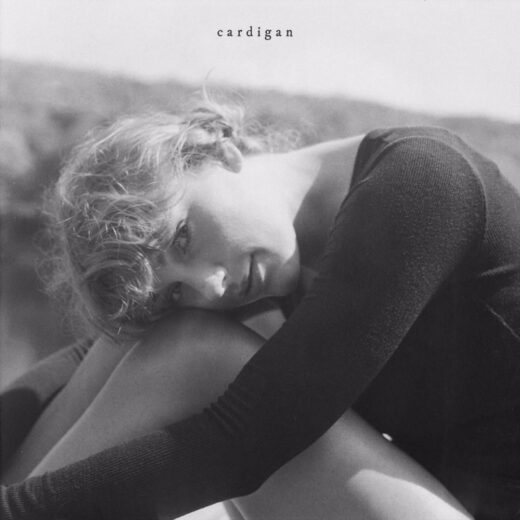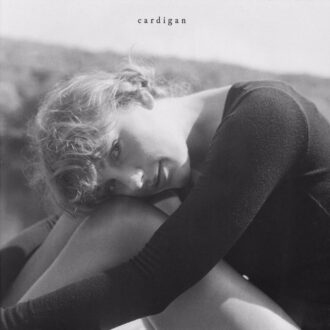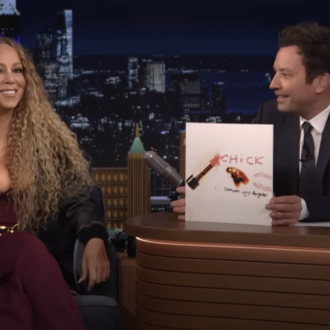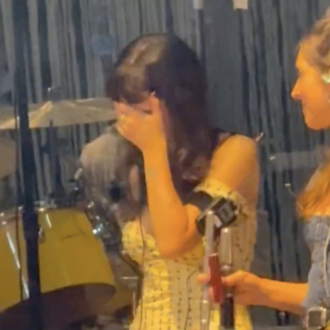In The Number Ones, I’m reviewing every single #1 single in the history of the Billboard Hot 100, starting with the chart’s beginning, in 1958, and working my way up into the present. Book Bonus Beat: The Number Ones: Twenty Chart-Topping Hits That Reveal the History of Pop Music.
“This is a highly unorthodox career move.” That’s something that a record-label exec says in the trailer for Springsteen: Deliver Me From Nowhere, the new biopic about some guy who has never properly appeared in this column. Biopics need guys like that to say things like that. They inevitably turn out to be wrong. That’s the point. The classic albums are all highly unorthodox career moves, made in defiance of this exact type of record-label exec. You can only ascend into the pantheon by making highly unorthodox career moves. When someone inevitably makes a Taylor Swift biopic, or maybe a series of Taylor Swift biopics, or maybe a Taylor Swift career-retrospective hologram-play that’ll be broadcast on the surface of the moon, some record-label exec will say the same thing about Folklore.
Springsteen: Deliver Me From Nowhere is about the recording of Nebraska, the haunted acoustic four-track album that Bruce Springsteen made before the blockbuster explosion of Born In The USA. Folklore is not a haunted acoustic four-track album, but it’s as close to that model as Taylor Swift is likely to ever get. Coming from someone who really only ever made blockbuster explosions, Folklore was a fascinating move, and maybe even a highly unorthodox one. When the entire world went into sleepy lockdown mode, Taylor Swift called up the guy from the National and made a record of soft, evocative, NPR-friendly indie folk. It was the least knowingly pop thing that Swift had ever done, but it still registered as pop because it was still a Taylor Swift album. It also roped in people who had never really taken Swift seriously. And it’s a really good record. By absolutely any metric, Folklore was a fantastic success.
Part of the magic of Folklore was that it didn’t have an endless rollout full of brand partnerships and televised pomp. Nobody had a chance to get sick of the record before it came out. Nobody had a chance to carve it up into prospective singles, either. Instead, Swift simply announced the album on Instagram mere hours before its release, sending the music critics of the world into mad-scramble mode. (I got my review up at 4:35 p.m. on release day, and I wish I’d been a little faster with it. For successive Swift album rollouts, I’d shave an hour or two off of that time.) “Cardigan,” track two on Folklore, was the song that had a music video, so it’s the one that went straight to #1. It’s not the best or catchiest song on the record, but it’s the one that’s getting its own column today.
It would be ridiculous to say that Taylor Swift’s career was in trouble before she made Folklore. Taylor Swift’s career has not been in trouble for one single second of her entire life. She’d joined the forever-legend realm before she hit drinking age. She’d sold kajillions of records, dominating commercially to an extent that only someone like Adele could plausibly challenge. She had two Album Of The Year Grammys. The Kanye West business was behind her; she’d won that long war of attrition quite handily. Swift had then won another PR war when big-deal manager Scooter Braun bought the masters for the albums that she recorded for Big Machine, giving her the opportunity to spotlight the fucked-up state of intellectual property law and setting the table for her almost unfathomably successful project of re-recording her old music. Reputation and Lover were the biggest-selling albums of their respective years. Swift was doing just fine.
But she needed a rebrand, a different narrative, something. Her album 1989 had been so huge, so dominant, that the two that came after it felt somehow smaller. Reputation only sent one song to #1, and that one, “Look What You Made Me Do,” wasn’t anyone’s favorite Swift song. At least in the moment, Lover didn’t sent any songs to #1, and her attempts at big singles, “Me!” and “You Need To Calm Down,” both felt like grating, pandering, tone-deaf nothings. Both of them peaked at #2, getting stuffed by the ongoing “Old Town Road” phenomenon. (“Me!” is a 3, and “You Need To Calm Down” is a 4. A different Lover track will eventually appear in this column, but not for a while.) Swift moved far beyond her country music origins only to repeatedly lose out to a piece of cowboy-themed kitsch. You know she didn’t like that.
In the 2020 Netflix documentary Miss Americana, there’s a scene where a pajama-clad, visibly bummed-out Taylor Swift finds out that Reputation didn’t get a Grammy nomination for Album Of The Year. She takes a moment and then she tells the person on the other end of the line — I think it’s publicist Tree Paine — “You know what? Like, this is fine. I just needed to make a better record.” When the other voice insists (correctly, in my opinion) that Reputation is a great record, Swift says, “No, I’m making… I’m making a better record.” Lover is another great record, butt-ass singles notwithstanding, but it didn’t get the Album Of The Year nom, either. That might not mean anything to you or me, but it probably means something to Taylor Swift. One thing that might mean something to you is Swift’s participation in the catastrophic 2019 Cats movie, a pop-cultural punchline from the moment that the first trailer dropped. She really should’ve seen that one coming.
Taylor Swift was still a dominant pop star, probably the dominant pop star, but things were not trending in the right direction. She needed a moment to step back, reconsider, and perhaps alter her course just slightly. The world gifted her an opportunity to do exactly that. Swift planned to do some light touring after Lover came out in fall 2019, but COVID changed those plans. For a minute, Swift was like everyone else — bored at home, drinking wine and watching old movies. For her, that phase did not last long. In April 2020, Swift texted the National’s Aaron Dessner about the possibility of making some music together. Three months later, they had a whole album ready for a surprise release.
The National are the kind of band that gets a lot of coverage on this website but not in this column, if that makes sense. They were one of the defining indie rock bands of the ’00s and ’10s — dour hangdog handsome men generating great quasi-orchestral emotional swells about that disaffected middle-aged dad life. I first saw the National in 2005, when they were on tour with hype darlings Clap Your Hands Say Yeah, famously blowing that band offstage every night even though lots of people left before their set. They grew into hard-touring pavilion act, and I heard their music at multiple dinner parties. They continue to make NPR-core indie rock. That’s not the most exciting thing in the world, but they’re very good at it.
The National were a very big band in 2020, but they weren’t really at their artistic peak. Their 2019 album I Am Easy To Find did not leave a deep impression on me. Aaron Dessner, one of the National’s two twin-brother multi-instrumentalists, had been producing for a while, working with fellow indie artists like Sharon Van Etten, Local Natives, and Frightened Rabbit. Aaron and his brother Bryce worked together to co-produce Dark Was The Night, a 2009 double-disc benefit compilation of most of the big acts in that moment of respectable, prestige-heavy indie music. But the National weren’t about to trouble the Hot 100, and neither were any of people who Dessner was producing. (The National still don’t have any Hot 100 hits as lead artists, but they’re credited as featured guests on “Coney Island,” the duet that Taylor Swift sang with bandleader Matt Berninger later in 2020. That one peaked at #63.)
Taylor Swift liked the National. She wasn’t a hyper-vocal fan or anything, but I remember being interested when she included the band’s side project El Vy on some playlist. Swift’s interest in the band wasn’t honestly that surprising. Their music fit right into the comfortable, homey aesthetic that she sometimes cultivated. You can imagine her, after that scene in Miss Americana, consoling herself over Grammy snubs by throwing on Trouble Will Find Me. Aaron Dessner first met Swift in 2014, when the National were the musical guests on a Saturday Night Live episode hosted by Swift’s friend Lena Dunham. She met him again in 2019, when she went to see the band play a rainy outdoor show in Brooklyn’s Prospect Park. There, Swift and Dessner got to talking about songwriting process, and Dessner told Swift that he and his brother work by putting together instrumental beds and then sending them to Matt Berninger. That lit a spark. Swift figured that she could maybe work like that.
Therein lies the highly unorthodox career move. Virtually every review of Folklore, including mine, referenced the “We Are Never Ever Getting Back Together” line about Swift’s ex bumping “some indie record that’s much cooler than mine.” Eight years later, Swift made her own indie record. But Folklore wasn’t necessarily cooler than anyone else’s record. The National didn’t make intimidatingly cool music. In some ways, their sound is as comforting and reassuring as anything that Swift ever made. Folklore was a fascinating individual enterprise that came out of a particular set of circumstances, but it worked as a culmination of a process that had already been happening for years.
Last month, my friend and colleague Chris DeVille published his book Such Great Heights: The Complete Cultural History Of The Indie Rock Explosion. (Cop that shit.) Chris’ book lays out the long process of indie rock becoming some version of pop over the course of the 2000s and 2010s, and that story reaches its apex and inevitable ending with Folklore. The National weren’t exactly an underground band before Taylor Swift got hold of Aaron Dessner. They belonged to the touring-band middle class, which seems like a nice place to be. But Swift had a vision, and she took the National’s style to the absolute heights of pop music. Together, Swift and Dessner discovered that the world was ready for exactly that.
When Swift texted Dessner, he was working on new music of his own. He had a bunch of instrumental tracks that Matt Berninger hadn’t figured out how to turn into songs. One of those instrumental tracks was “Cardigan.” It soon became the first song that Dessner and Swift wrote together. Dessner emailed Swift a folder full of tracks, not sure if anything would actually happen with them. Within a few hours, she sent back a voice memo of “Cardigan,” already fully written. Dessner later told Pitchfork, “That’s when I realized that this was unusual — just the focus and clarity of her ideas. It was pretty astonishing.” I bet it was! Every once in a while, Taylor Swift will get an opportunity to show someone else what a fucking songwriting machine she is. I love those stories.
For a few months, Aaron Dessner and Taylor Swift worked together in total secrecy, emailing files back and forth. Swift worked at her home studio in Los Angeles, and Dessner worked at his home studio in Upstate New York. Dessner brought in collaborators like his brother Bryce, who did the string arrangement on “Cardigan,” and Bon Iver’s Justin Vernon, his partner in the side project Big Red Machine. But Aaron Dessner couldn’t tell anyone else about the project — not even his daughter, a big Taylor fan. Swift also worked on tracks with her longtime collaborator Jack Antonoff. While everyone else went through stages of pandemic boredom and anger and acceptance, Taylor Swift threw herself into the making of Folklore. Within a few months, the album was done, ready to go. Her own label didn’t even know of its existence until the moments before she announced it. It was a genuine bolt of surprise and excitement — first the very idea that Taylor Swift made an album with all these indie-folk guys and then the actual album, which fucking slaps.
I don’t think Folklore is the best Taylor Swift album. It might not even make my top five, honestly. There are definitely some long, sedate bits where my attention wanders. But there are also lots and lots of absolutely incredible songs — “The Last Great American Dynasty,” “My Tears Ricochet,” “Mirrorball,” “This Is Me Trying,” “Invisible String,” motherfucking “Betty.” More to the point, Folklore was a clear signal, to anyone who’d ignored the many previous clear signals, that Taylor Swift was the real deal. Her sparkly melodies and sensitively plainspoken vocals mesh beautifully with Aaron Dessner’s sweepingly tasteful production. To some critics, that was a problem, since that sweeping tastefulness leaves no room for regular pop-music abandon. But it opens up space for things like soft, downbeat introspection, and Swift can do all that stuff amazingly well, too. It might not be the best Swift LP, but I’d put Folklore above any album from the National. (My favorite National album is Alligator, which rules. Folklore rules harder.)
A few years before Folklore, the now-disgraced indie-ish guy Ryan Adams released a full-album cover of Swift’s 1989, and I heard that album in the types of coffee shops where I never heard Swift’s actual music. With Folklore, it was like she made her own Ryan Adams version of 1989 — a blockbuster pop album that would absolutely make sense playing over the speakers at a bougie bookstore or a craft brewery. A lot of other dads in my circle, guys who don’t pay any attention to current pop music, mentioned that, you know what, that new Taylor Swift album is pretty good. They were right. Folklore was immediately a huge deal, but it wasn’t made with the Hot 100 in mind. For really the first time, Swift wasn’t chasing radio play, and she didn’t really get it. Instead, “Cardigan” debuted at #1 thanks to streams and downloads, driven by Swift’s starpower and the element of surprise.
Taylor Swift did not write “Cardigan” about herself. Instead, it’s the first part of what Swift calls her Teenage Love Triangle trilogy, a set of three Folklore songs about fictional kid characters suffering heartbreak and drama before getting finally coming back to love. It’s like Swift realized that some of her best songs were the teenage-frustration laments that she wrote when she was an actual teenager. Just after turning 30, she went back to that well, doing her best to recapture the stormy intensity of those emotions. Some of those attempts work better than others. It’s hard to summon that same fire when you’re not talking about your own life. Sometimes, she could do it. “Betty,” the final song of the trilogy, is a Swift classic. “Cardigan” is not. It’s OK, though.
“Cardigan” plink-plonks away softly, with Swift intoning lines about a vintage tee and a brand-new phone over Aaron Dessner’s drum-machine ripples and plangent pianos. (The first bunch of times I heard it, I thought the opening line was about “vintage tea,” and I was like, “Ew, who would drink vintage tea? It would taste all musty!” This is not a reflection on Taylor Swift. It’s just me being stupid.) As the strings and mellotrons slowly unspool, Swift’s narrator describes the way that an ex used to make them feel: “When I felt like I was an old cardigan under someone’s bed, you put me on and said I was your favorite.” So when that person leaves the narrator’s life, it stings that much more: “I knew you’d linger like a tattoo kiss/ I knew you’d haunt all of my what-ifs.” It’s a comfy song and it’s about comfort, both in its central metaphor and the way that feeling of security disappears when things fall apart.
The writing on “Cardigan,” and on much of Folklore, is a lot more flowery than anything that Swift had really attempted to that point. I think that adjustment is the main reason that she called herself “your English teacher” when she announced her engagement last month. Those poetic affectations don’t all work for me. This line clangs off the rim: “You drew stars around my scars, but now I’m bleedin’.” Also, I don’t like the bit about “Peter losing Wendy.” I just got done with the first Alien: Earth season, and I think it’s time that we all stopped using Peter Pan metaphors. It’s done. That keg is kicked. Leave it alone. Swift’s melodies on “Cardigan” never quite grab me, but they have a pleasant grace, drawing little curlicues in the air. Vocally, she sells the character’s fond desolation. I feel protective of that character, even if the song mostly fades into the background.
Swift always leaves me something to hang onto. On “Cardigan,” it’s that central sense of ache. She’s rendered that ache better plenty of times, but it still resonates here. The song feels like what it is — an early, tentative step in a new writing partnership. Swift and Dessner quickly cranked out a whole lot of work that, at least for me, hits a lot harder than “Cardigan.” But I wonder if Swift feels extra-strong about “Cardigan” because it’s the song that unlocked the possibilities of that partnership. In any case, “Cardigan” was the Folklore song that got the nominal-single treatment. It’s the one with a video. This means that it fits right into the long, proud tradition of Swift choosing not-great first singles from her albums. This time, though, the choice was not an embarrassment.
Taylor Swift directed her own “Cardigan” video, working with a small team under lockdown conditions, and she’s the only person who appears onscreen. I think the video is pretty bad. Swift is playing piano in a dusty attic, and then she’s amazed when she opens the lid and a glowing Spielbergian light shines out. So she climbs into the piano, and then she’s in a verdant green dreamworld, playing a piano that’s all covered in moss, with a CGI waterfall coming out of it. Then she climbs into that piano, and she’s floating in a river, and she has to go swimming after yet another piano. One more piano-portal later, she’s back in her dusty attic, pulling on a cardigan because she’s all wet. I’m sure the video is all full of subtle allegories and allusions to her own mythology, but I think it looks like a homemade Etsy version of a Hallmark card. Also, Swift started selling that cardigan on her website right away. She’s still threatening to direct an actual movie, and this video does not instill me with hope that we’ll all discover that she’s really a metaphorical third Coen brother.
“Cardigan” debuted at #1 thanks to sales and streaming; it got almost no radio play. Two more Folklore tracks debuted in the top 10, with the tentative opener “The 1” coming in at #4 and the Bon Iver duet “Exile” at #6. (“The 1” is a 7, and “Exile” is an 8.) A week after Folklore came out, “Cardigan” fell to #8 — not as extreme a drop as we’ve seen in this column lately, but pretty steep regardless. In a summer when most of the #1 hits were loud, crass collaborations from multiple famous musicians, it felt like a big change to have this soft-thrumming singer-songwriter record on top, however briefly. But Folklore turned out to be exactly the right kind of counter-programming. It was delicately bummed-out music that clicked with a larger cultural mood, and it made sense as streaming-service mood music. It also helped build a narrative about Swift’s understated artistry, something that was always there but maybe not quite so obvious.
Once again, Taylor Swift made the biggest-selling album of the year. Once again, she won the Grammy for Album Of The Year in 2021 — her third victory, moving her into a four-way tie with past Number Ones artists Frank Sinatra, Stevie Wonder, and Paul Simon. She would later win a fourth trophy and pull away from those bums, standing alone as the one true Grammy champion. During that campaign, “Cardigan” remained front and center. Later in 2020, Swift filmed The Long Pond Sessions, a Disney+ special where she performed the whole Folklore album straight through, backed up by Aaron Dessner and Jack Antonoff, at Dessner’s studio. “Cardigan” was part of that. At the COVID-distanced Grammys where she won for Folklore, Swift, once again backed up by Antonoff and Dessner, sang a medley of the three Teenage Love Triangle songs in a stage set made to look like a dewy, fantastical log cabin.
When Folklore came out, I did not imagine that its songs would make any sense in a stadium. For a minute there, I thought that maybe Swift was done touring stadiums, that this kind of chamber-folk simply could not translate into grand spectacle. This is why you should never listen to me. What was I thinking? Of course Swift found a way to make that work. At the Eras Tour, Swift brought the log-cabin set back, and she sang “Cardigan” while draped across its roof. It wasn’t the best part of the show, but it worked just fine. Today, “Cardigan” has upwards of a billion Spotify streams, more than any other Folklore track, so I guess not everyone agrees with me that it’s a bit of an album lowlight. I would not put “Cardigan” in the grand pantheon of Taylor Swift singles, but that’s fine; that particular pantheon is crowded. And anyway, Swift is almost certainly about to add another Hot 100 chart-topper to her total two weeks from today. In the columns ahead, we’ll talk about plenty more Taylor Swift career moves, orthodox or otherwise.
GRADE: 6/10
BONUS BEATS: It brings me no joy to report that Yungblud, the disconcertingly plastic-looking young British rock yowler who may or may not be AI-generated, covered “Cardigan” in the BBC Live Lounge and mashed it up with former Number Ones artist Avril Lavigne’s 2002 hit “I’m With You.” Here’s that:
(“I’m With You” peaked at #4. It’s a 7.)
The Number Ones: Twenty Chart-Topping Hits That Reveal The History Of Pop Music is out now via Hachette Books. And when I felt like I was an old cardigan under someone’s bed, you bought the book and said it was your favorite.




